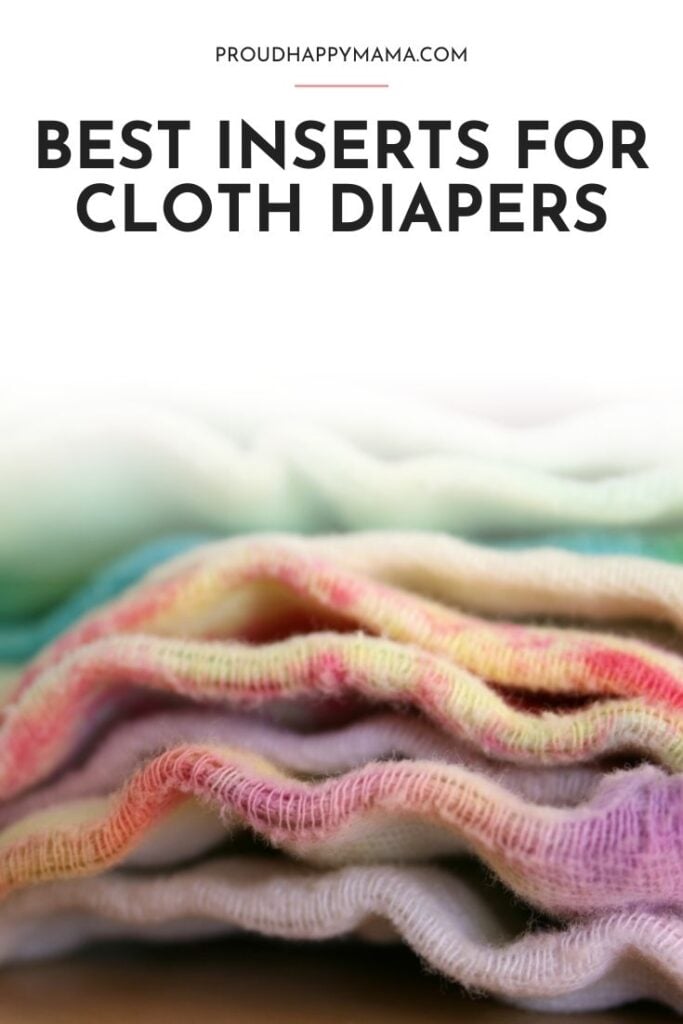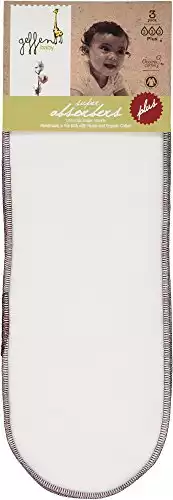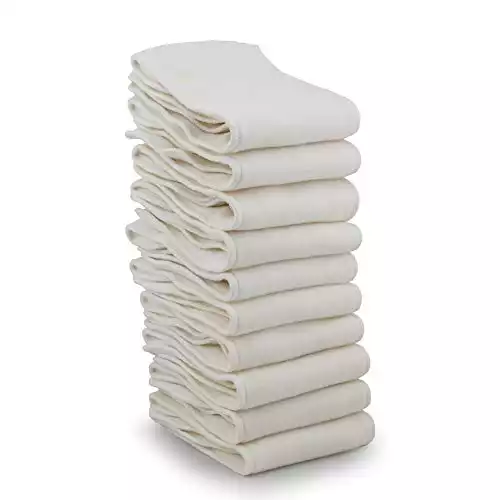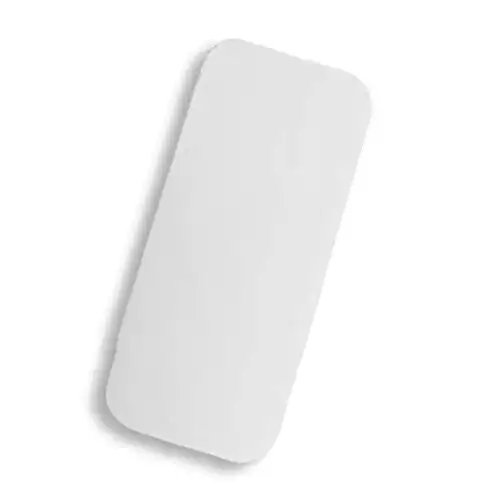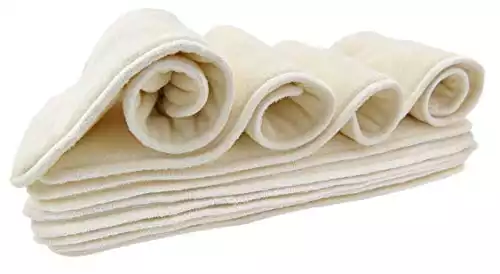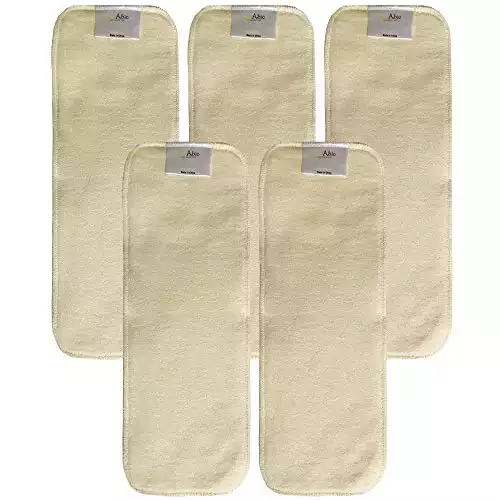Best Inserts For Cloth Diapers
Trying to find the best inserts for cloth diapers?
Then let us help you decided on the best diaper inserts for you and your baby!
Lots of us are choosing to make the switch from disposable to cloth diapers. And while it’s a great decision for you, your family, and the environment, the terminology can get confusing. Liners? Inserts? Boosters? You’d better learn what it means, or you’ll have one leaky baby!
The right inserts are essential to add absorbency to your cloth diaper. But the choice is vast, and each brand boasts exceptional qualities.
Getting the perfect absorbency level is all about fabric choice, layers, sizing, and tricky combinations.
If that all sounds confusing, don’t worry. That’s why we’ve put together this guide to the most absorbent cloth diaper inserts!
And if you love this guide on inserts for cloth diapers, then make sure to check out these guides on how many cloth diaper covers and inserts do I need, different types of cloth diapers, and best diaper cream for cloth diapers.
This post contains affiliate links. See our full disclosure here
These Geffern baby inserts absorb large amounts, quickly!
Made of a cotton and hemp blend these inserts are fast becoming one of the most popular choices for cloth diapering parents.
Each insert is made of 5 layers, with 60% hemp and 40% organic cotton fleece construction.
And with no synthetic materials used, they are soft against your baby's skin.
List of 5 Best Inserts For Cloth Diapers
Most Absorbent Cloth Diaper Inserts
1. Geffen Baby Super Absorbers Plus – Universal Cloth Diaper Inserts
The adaptable and absorbent inserts from Geffen Baby are fast becoming one of the most popular choices for new parents.
We think they’re fantastic, especially as the universal shape allows them to be used with a range of diapers.
Geffen Baby makes their inserts from a blend of hemp and organic cotton fibers. Each insert is made of 5 layers, with 60% hemp and 40% organic cotton fleece construction.
Geffen Baby have claimed that there are no synthetic materials used, so the inserts won’t curl when damp.
Thanks to the gentle materials, the Geffen Baby inserts can be placed against your baby’s skin. They’re soft to the touch and have an incredible absorbency.
There is some bulk, so if you’re after trimness, Geffen might not be what you need. But if you don’t mind padding, you’ll be happy with the results.
Geffen Baby have created an insert that should fit comfortably in whatever cloth diapers or pocket diapers you use. Be prepared for some folding to get the size just right, but the reduced leakage is worth the effort.
And your baby will love it too, thanks to the soft touch of these inserts.
Pros
- Cotton/hemp blend – Absorbs large amounts, quickly.
- 5 layers – Extra absorbency, even if there is some added bulk.
- Gains absorbance over time – The more you use and wash these inserts, the better they become.
Cons
- Needs lots of prep – To get to the best level of absorbency, you need to spend a lot of time washing.
These Geffern baby inserts absorb large amounts, quickly!
Made of a cotton and hemp blend these inserts are fast becoming one of the most popular choices for cloth diapering parents.
Each insert is made of 5 layers, with 60% hemp and 40% organic cotton fleece construction.
And with no synthetic materials used, they are soft against your baby's skin.
2. Kanga Care Rumparooz Rayon From Bamboo 6R Soaker
You have to pay a little extra to get the incredible quality of these Kanga Care Inserts, but the bamboo fabric blend offers exceptional absorbency for heavy wetters.
And the fabric locks in moisture, so leaks are prevented even over long nights.
Each 6R soaker from Kanga care is actually a combination of two inserts. There’s the contoured newborn insert, which comes with two snaps and a thickness of three layers.
And the one-size insert, with various snaps and three layers of thickness.
Why have two inserts? The advantage of this system is that you can really adapt the inserts to suit your baby’s needs.
Use just the smaller insert for a newborn, the larger as they start to grow, and double up for heavier wetters.
The multiple snap settings make positioning easier, especially when it comes to doubling up!
We like the bamboo rayon option from Kanga Care, which combines 50% bamboo rayon, 20% organic cotton, and 30% polyester. But Kanga Care also makes hemp and microfiber inserts.
Purchase all three packs, and you can really personalize the absorbency for your baby’s needs.
Pros
- Two liner system – Add six layers of absorbency in your own way using the two liners and multiple snaps.
- Bamboo rayon blend – A mixture of natural heavy absorbency and fast synthetic absorbency.
- Soft – Gentle, even when against the skin.
Cons
- Bulky – The adjustable layers are good but can make the insert bulky.
3. Thirsties Hemp/Organic Cotton Inserts
Thirsties are a hugely popular brand, and if you pick up a pack of these low cost inserts, you’ll soon understand just what makes them so great. Absorbent, soft, and budget friendly, these are an all-round impressive insert.
Like many cotton and hemp blend inserts, Thirsties uses 55% hemp and 45% cotton.
They also carefully source certified organic cotton, so you know your reusable inserts are even better for the environment.
Each insert is made of six layers of soft hemp and a durable cotton jersey knit.
Thirsties are good overnight inserts, and they can keep your baby dry throughout the night. Even heavy wetters should be leak-free in the morning.
You’ll be impressed by the absorbency of Thirsties right away, but it only gets better the more you use and wash the hemp.
But watch out for the long drying times that can make Thirsties less than ideal for busy parents.
Overall, we love that Thirsties have created a quality liner that’s easily affordable, making eco-friendly parenting more accessible.
Pros
- 6 layers – Extra absorbency, but less bulk. Good for overnight use.
- Low cost – A budget-friendly liner that doesn’t sacrifice quality to save money.
- Size – The bigger size shrinks down in the wash to fit perfectly in a variety of diapers. But the thinner build makes the insert easier to fold if necessary.
Cons
- Long drying time – Once you’ve washed these liners, be prepared that they take a while to dry. As they need several washes before first use, this can be frustrating.
4. Nora’s Nursery Bamboo Cloth Diapers Inserts
Nora’s Nursery have created their diaper inserts using an interesting blend of fabrics. The outer layers are crafted from bamboo viscose, while the inner layers are made up of microfiber.
The result is an insert with improved absorbency, less staining, and a comfortable finish against delicate baby skin.
The Nora’s Nursery inserts are also contoured for an improved fit, meaning you’re less likely to find leaks. And the liners shouldn’t shift as your baby moves.
This once again reduces the risk of leaks, and keeps your baby comfortable.
Thanks to the blend of microfiber and bamboo, these are some very absorbent inserts. But they don’t have extra bulk, so you’re able to double up without weighing the diaper down.
They feel thinner than the standard microfiber inserts, so can be used as a booster for overnights.
Something else to love about the Nora’s Nursery inserts is the price. These are incredibly budget-friendly, even for a 10 pack. Thanks to the thinness, you can really layer up these inserts to save money. They’re also adaptable and able to fit in most diapers.
Pros
- Bamboo and microfiber blend – Gentle against the skin, and absorbs quickly.
- Low cost – A high quality insert that won’t break the bank.
- Contoured design – The gusset is shaped to prevent leaks and to keep the insert anchored as your baby moves.
Cons
- Microfiber can hold onto smells.
5. EcoAble Hemp Diaper Inserts: Overnight Cloth Diaper Double Booster Pads
These EcoAble hemp inserts are actually doublers, but we think that they’re worth including in this round up.
Layer them alongside your favorite cloth insert, and you’ll be impressed with what these gentle and durable double boosters can do.
As a doubler, these inserts are designed to add an impressive amount of absorbency without increasing the bulk. Instead, they slip easily into the diaper, and will feel lovely against your baby’s delicate skin.
And thanks to the 55% hemp and 45% cotton blend, they’ll do a great job at soaking everything up without causing a rash.
We think the best time to use these EcoAble inserts is overnight. Layer under a bamboo insert, and you’ll have a hardworking doubler that won’t lead to leaks, even from heavy wetters.
The EcoAble boosters are inexpensive, allowing you to add extra layers of protection at low cost. They’re also incredibly durable, and will only improve with extra washes.
These are boosters that will support you and your baby for a long time, with a thinner fold, adapting the booster as your baby grows.
Pros
- Hemp and cotton blend – Fast absorbing cotton pairs with the long-lasting hemp for an impressive insert.
- Budget – A low-cost booster that’s available in several pack sizes.
- Durable – Won’t fall apart with the excessive washes needed to show hemp at its best.
Cons
- Can turn stiff, and lacks bend after too many washes.
Buyer’s Guide to Best Cloth Diaper Inserts
If you’ve been using disposable liners, it might seem like a daunting task to switch to cloth. We know how much you want to make the change, though, and we’re here to help you get started.
There are a few key components to consider when buying cloth inserts — things that you might not have had to think about when buying disposable inserts.
We hope that with this guide you’ll be able to choose the right inserts for your baby, your needs, and your budget!
Inserts Vs Doublers Vs Boosters Vs Liners
There’s some confusing terminology used when it comes to buying cloth inserts. You have to know the difference between your liners and your boosters, or you’re going to have to deal with a lot of leaks.
- Inserts do the bulk of the absorbing. They can be put into pocket diapers or laid in. Some inserts will also come with snaps, to be snapped into place on the diaper.
For a very young baby or a light wetter, the insert may be able to work on its own. For heavy wetters, the insert should hold plenty, but will need some extra back up.
- Doublers are an extra layer, designed to double up the absorbency without adding too much bulk. They tend to be made of natural fibers, which can absorb a lot, but do so slower.
A doubler can’t be used alone, or you can expect leaks.
- Boosters are very similar to doublers. They should be thin and made of natural materials. Like the doubler, a booster shouldn’t be used on its own. Boosters are best used when you need a bit more absorbency, but don’t want extra bulk in the diaper.
- Liners are quite different to the other three, so you don’t want to get them confused. Liners are a thin layer that provides a barrier between the diaper and the skin.
It isn’t absorbent, so should not be used in place of an insert. Use a liner if the fabric of the insert shouldn’t be placed next to skin, or if you’re using diaper creams.
Materials
Material is probably the most important factor in choosing a diaper insert. The properties of these materials will help you determine exactly what is needed for your child.
- Microfiber is cheap, and its best property is quick absorption. Microfibers are great for light wetters because they can soak up a lot of liquid quickly.
However, microfiber tends to feel scratchy against the skin and doesn’t provide extra protection for heavy wetters. They’re also synthetic, which is less safe for the environment.
- Cotton is the classic choice, and still a popular one today. Cotton absorbs fairly quickly and holds moisture well.
It feels soft against the skin and is easy to care for. However, cotton can be bulky. Cotton inserts often come in a fabric blend.
- Bamboo is a more expensive option than cotton, but it has similar absorbency without the extra bulk. It also doesn’t need to be washed extensively to reach its optimal efficiency.
Bamboo will typically be layered with another fabric.
- Hemp has become very common because it’s one of the most absorbent materials available. It needs a few washes before use, but then it only gets better the more you use it and the more you wash it.
As it absorbs slowly, hemp will generally be blended with another fabric, to prevent leaks.
Many parents like to layer inserts made of different fabrics, to get the best properties of each.
Layers Of Fabric
Another key factor in the absorbency is how many layers the insert has. Anywhere between 3 and 6 is pretty standard, although you do get some that are thicker or thinner.
Check the layering and the fabric to find the perfect absorbency level for your baby. A 3 layer insert might do for a light wetter, but a heavy wetter will probably need closer to 6.
Size
When you first get your diaper inserts, they’re probably going to look huge. Don’t worry, after a hot wash, they’ll start to shrink down.
Inserts don’t really come in different sizes for different age groups, although you can get some that are smaller than others. Instead, it’s best to fold the inserts to ensure they fit in the diaper.
With that said, some inserts don’t have a universal fit. If the brand also makes their own diapers, double-check the sizing of the insert to ensure it has some adaptability.
Bulk Or Trim
This factor – bulk or trim – is very much related to both size and layers of fabric. Ideally, a trim insert is better. It allows for movement, and your baby is less likely to overheat.
However, trim inserts do tend to lack some absorbency. Bulk is, unfortunately, a necessity for a heavy wetter.
Often, the best thing to do is to combine bulk inserts with trim inserts of different fabrics, to get the best of both.
Price
In the long run, using a fabric insert is sure to save you money. Once you’ve found your preferred brand, you can stock up and keep costs low.
However, each pack can be expensive. Try to buy in bulk, to save money.
Eco-Credentials
There are plenty of reasons to start using cloth diapers, but a big reason parents have gone back to this older method is to avoid excess waste.
Check the eco-credentials of your cloth inserts to find where they source the fabric, and how durable each insert will be.
FAQs on Cloth Diaper Inserts
The most absorbent material for heavy absorption in cloth diapers is hemp. It can absorb a lot but it is important to note it does so slowly. Microfiber is at the opposite end of the scale. It absorbs quickly, but can’t hold quite as much. Cotton and bamboo are somewhere in the middle.
Pocket diapers, Hybrids, and Fitteds & Cloth Diaper Covers all use different cloth diaper inserts and materials. Cloth diaper inserts usually come with pocket diapers, but they are available to buy individually for extra absorbency.
The best cloth diaper insert should combine absorbency with comfort. You want something that is soft against your baby’s skin, doesn’t irritate them, but can also absorb a lot without leaking. Try layering different fabrics, to get the best absorbency qualities of each.
Final Thoughts on Best Diaper Inserts
We hope that this guide can help you find the right inserts for your cloth diapers. Remember that there’s no such thing as the perfect insert. Instead, look for what’s right for your child’s needs.
What fabric you choose can make a huge difference to absorbency, leaks, and comfort.
And if you’re looking for more great diapering guides, then check out these guides on best washing machine for cloth diapers, best wet bag for cloth diapers, how many cloth diaper covers and inserts do I need, and best detergents for cloth diapers.
